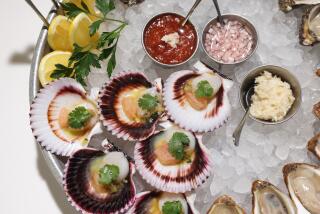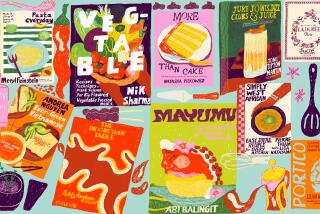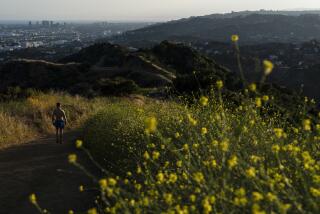Where the Wild Things Grew
- Share via
When I was growing up in Southern California, traces of my neighborhood’s agricultural past could still be found. Down the block from my house was a citrus grove, and across the street was a big field where my grandmother would gather wild mustard greens. I remember the smell of the leaves, a sharp fragrance that filled the kitchen. My grandmother would boil the greens in a big pot until the water turned dark, and I would gaze into its murky depths and breathe in the strong mineral aroma.
I loved to drink this bitter broth and instinctively knew it was good for me, just as a wild animal knows which leaves and grasses to eat to stay healthy and vital, and which plants have curative powers.
Other plants grew wild around our suburban home. When my grandmother spotted purslane growing in the dry, cracked earth--succulent green leaves and fleshy pink stems--she would pick them and use the leaves in a small salad dressed with olive oil and vinegar. She also gathered wild dandelions, which she would boil, eating the greens and drinking the water in which they cooked.
And after a rain, when the ground was moist and dark, she would go out into the yard and gather the mushrooms that had magically appeared overnight. My mother was horrified to see her eat these mushrooms--she grew up in Palermo and was more accustomed to afternoon pastries and espresso than she was to the ways of country people. She refused to eat the mushrooms fried with eggs that my grandmother prepared, even though she admits that the smell was exquisite.
Although we feared for my grandmother’s life, she lived to be 101, so her connection to the wilderness served her well.
As our small suburban California town expanded in a frenzy of unplanned growth, the field of wild greens was replaced by a parking lot (just as Joni Mitchell sang), and then the purslane just stopped growing. Perhaps it lost its will to survive once the wildness had gone out of the air, but probably it was the smog or, more likely, the chemicals that everyone sprayed on their lawns.
It was only when I went to Italy after college that I began to discover again the world of wild foods. In outdoor markets I saw wild asparagus, big brown forest mushrooms smelling of damp earth and all kinds of wild greens. The availability of wild plants reflects the profound connection to the earth that still exists there, based on a long tradition of agriculture and living close to the land.
I was excited to eat these foods with their heightened flavors--stronger, purer, more like the distilled essence of how we imagine they should taste. When in season, these wild foods are offered in restaurants. The season is often brief, which adds to the excitement when the first of the wild strawberries are taken to market.
There is a knowledge of plants that is hidden in the natural world, something my grandmother was privy to--a knowledge that is far removed from the water-logged, chilled, cellophane-wrapped produce of commerce. It is found in freshly gathered vegetables and fruits still powdered with bloom; it is in the smell of wild green leaves and the feel of warm brown earth.
Recently, I was in a trattoria in Rome, eating a simple salad of wild arugula. The fresh green color, the tender outline of the leaves, the strong, oaky flavor all gave me great pleasure, but the deeper pleasure lay in the knowledge that in those leaves were contained all the mysteries of nature.
Although the following recipes call for plants that grow wild, I’ve also provided (when possible) suggestions for ingredients that are more commonly available but that still recreate some of the tastes of foods found in nature. When collecting wild foods, first make sure the area is untainted by chemicals or toxic by-products.
Use wild or cultivated mustard greens (cultivated greens can be found at many markets). The wild greens are particularly choice when eaten in spring. This is a strongly flavored dish, given a touch of sweetness by the presence of onions. Serve it as a first-course vegetable dish, a side dish or as a topping for bruschetta, piled on grilled bread while the greens and olives are still warm. As with most greens, the leaves cook down considerably, so be sure to start with plenty of raw greens.
SPICY MUSTARD GREENS WITH OLIVES
3 big bunches mustard greens
3 tablespoons extra-virgin olive oil
1/2 medium onion, finely diced
Dash crushed dried hot pepper
2 cloves garlic, finely chopped
1/2 cup oil-cured black olives, pitted and cut in half
Rinse mustard greens and cut off fibrous stems and ribs. Plunge wild greens into boiling water and cook until tender, about 30 minutes. (Domesticated greens are more tender and cook more quickly.) Drain well and set aside.
Combine olive oil, onion and crushed hot pepper in large saute pan. Cook, covered, over low heat until onion is very tender, about 10 minutes. Add garlic and cook 2 to 3 minutes longer. Add mustard greens and olives. Saute over low heat until greens have absorbed flavors of oil and all ingredients have had chance to interact, about few minutes. Makes 4 servings.
In Italy, this dish is made with porcini, a magnificent wild mushroom with a large, dark-brown cap and firm, succulent flesh. This same mushroom is sometimes available to us, either imported from Italy at prohibitively high prices or collected in our own forests.
Shiitake mushrooms, although not a true wild mushroom, are widely available and capture some of the earthy magic of those varieties gathered in the wild. For grilling, always select shiitakes with very large, thick caps.
The seasonings here are purposefully kept minimal. Strong, perfumed oregano sprinkled over the grilled mushrooms is a perfect accent to the intense flavor of the mushrooms.
GRILLED WILD MUSHROOMS WITH OREGANO
1 or 2 (depending on size) porcini or shiitake mushrooms per person
Extra-virgin olive oil
Salt
Freshly ground pepper
Dried Mediterranean oregano
If using shiitake mushrooms, cut off stems and discard. Wipe mushrooms clean with damp paper towel. Lightly brush both sides of mushrooms with olive oil. Season to taste with salt and pepper.
Heat grill (outdoor or stove-top cast-iron ridged grill). Lightly coat grill with olive oil. When very hot, place mushrooms on grill, gill sides up. Grill until slightly tender, turn and cook other side until just tender and moist. If mushrooms appear dry, brush with little olive oil. Take care not to overcook. Texture should be moist but slightly resistant.
Transfer mushrooms to platter and sprinkle with oregano. Serve with bread to soak up thin, savory juices. Makes 1 serving.
Wild fennel grows freely along the California coast, its soft, feathery foliage usually emerging from the earth in March. It does not develop the enlarged bulb found at the base of Florentine fennel, the variety sold in markets. Instead, the bright - green sprays of its highly aromatic leaves are used in cooking. Wild fennel is not sold commercially; if unavailable to you, substitute fennel bulb and fennel seeds, sauteed in a little olive oil until the fennel is tender, to duplicate the strong licorice flavor of the wild variety.
SPAGHETTINI WITH WILD FENNEL
1 (1/4 pound) bunch tender wild fennel
Salt
3 tablespoons extra-virgin olive oil
Dash crushed dried hot pepper
1/2 medium onion, finely diced
4 anchovies
2 tablespoons currants, plumped in warm water
Dash saffron dissolved in 1/2 cup water
Freshly ground pepper
1/2 pound imported dried spaghettini
1/4 cup pine nuts, lightly toasted
1/2 cup toasted bread crumbs flavored with few drops of extra-virgin olive oil
Wash and clean fennel well. Plunge fennel into big pan of boiling salted water and cook 10 minutes. Remove fennel with large slotted spoon and finely chop. Reserve water for cooking pasta.
Combine olive oil, crushed hot pepper and onion in large saute pan. Cook, covered, over low heat until onion is tender, about 10 minutes. Add anchovies and stir until melted. Add fennel, drained currants and saffron water. Season to taste with salt and pepper. Cook over low heat 10 minutes.
Add enough fresh water to reserved fennel water to fill pan. Bring to boil. Add spaghettini and cook until al dente. Reserve 1/2 cup of pasta cooking water. Drain and toss spaghettini with fennel sauce, pine nuts and reserved pasta water. There should be little extra juice in bottom of bowl. Serve with toasted bread crumbs on side, to sprinkle over pasta as you would grated cheese. Makes 2 to 3 servings.






